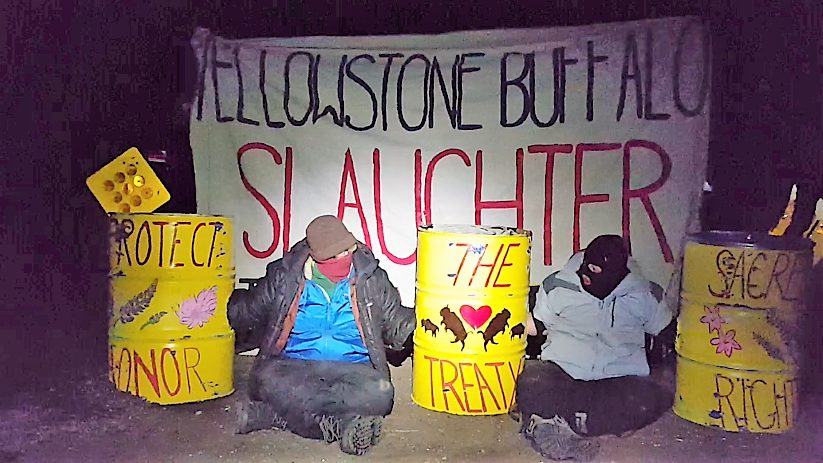
by DGR News Service | Mar 16, 2018 | Indigenous Autonomy, Obstruction & Occupation
March 16th 2018
For Immediate Release
Media Contact: Talon Brings Buffalo
406-404-9131
Stephens Creek Trap, Yellowstone National Park
March 16th 2018
Hours before dawn on Friday March 16th, two members of the Wild Buffalo Defense collective arrived at the gate of Yellowstone National Park’s Stephens Creek Buffalo capture facility. They blocked the gate with three 55 gallon drums filled with concrete, locking their arms inside the barrels. The three 1000 pound drums blocked access to the facility, preventing livestock trucks from taking the wild buffalo to slaughter. This action came in the wake of a similar event last week at the Stephens Creek Trap, where two buffalo protectors locked themselves to the hydraulic squeeze shoot using a metal pipe.
Wolf, the first individual locking down, described why he was taking the action: “My father is from Michaocan, Mexico, so I have both native and colonizer blood. Since I wasn’t raised in a native setting, this is my way to give back to the native community. I’m from Illinois — it’s called the Prairie State, and there’s less than one one-hundredth of the prairie left. It’s all strip malls and corn fields…I don’t like seeing just concrete and steel. Seeing how peaceful the buffalo are and how strong they are, they go through enough hardship in their lives in the forest and the plains and then with what Yellowstone National Park is doing to them they still carry on. They inspire me to keep going.”


Coyote, the other individual blocking the gate, said: “I’m doing this to get a better understanding of what is really going on and to protect the buffalo and the lands that they roam. I feel like I have been lost inside…but now that I’m here I feel more combined with myself, with others, and with knowledge and understanding. Whenever I’m with the buffalo I feel like my heart runs with them. When I’m with them they already know the questions, they already know the answers, and I don’t have to respond because they already know. I think it’s a good thing for people to learn. There’s not a day in this world where you’re not able to learn something. What we’re doing is something we love to do and we only live once so we should do what we love to do and if anybody wants to come out and join and learn this experience then they should.”
The barrels were painted with two phrases, “Protect the Sacred” and “Honor the Treaties.” The words highlight the fact that Buffalo are sacred creatures to the Plains Indians. Blackfeet and Lakota prophecies say that when the wild buffalo return, the people and the earth will be healed. Yellowstone National Park currently captures and slaughters about 25% of the herd every year. If this mismanagement of the population continues, these prophecies will… [press release ends].
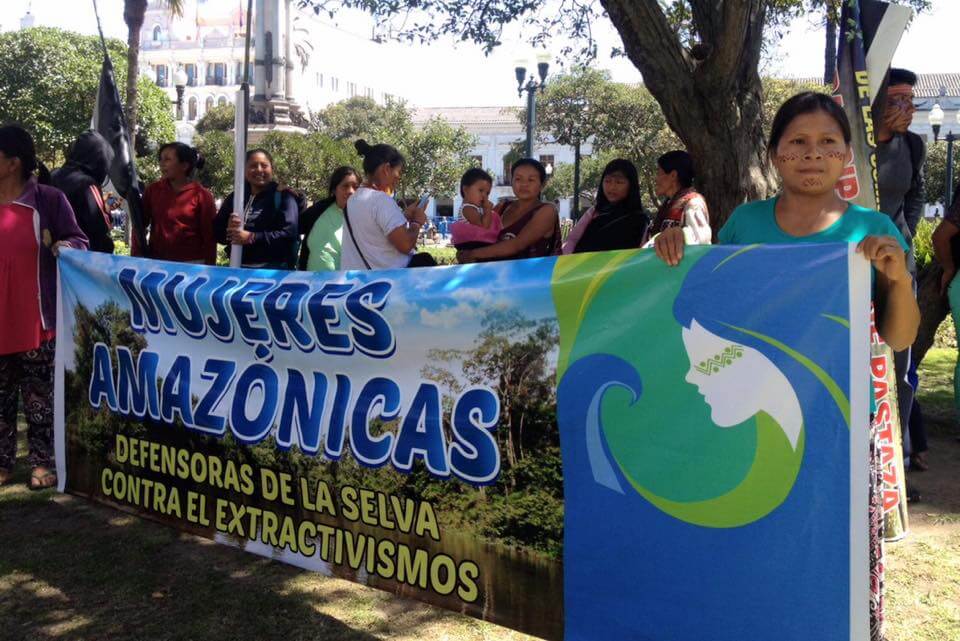
by Deep Green Resistance News Service | Mar 14, 2018 | Indigenous Autonomy
Featured image: Indigenous women gathered at the Independence Plaza to hand down their demands to the president. Credit: Yasunidos
by Pablo Orellana Matute / Intercontinental Cry
PUYO, ECUADOR – As in many spots around the globe, Women’s Day in Ecuador was marked by manifestations vindicating their role within society. For Indigenous women in the country, this was no exception. Unlike the short-lived momentum of the date, however, their strategy extended well beyond commemorative schedules. Their objective was clear: Their voices had to reach the country’s Presidential Palace.
For over nine months, political dialogues between Indigenous organizations and President Lenin Moreno’s government have left scattered results. Yet the gap from words to deeds remains firmly in place. The government’s reluctance to fully implement compromises was exposed when, early this month, the Minister of Hydrocarbons announced that a further oil auction is underway despite an explicit commitment to the contrary.
Or worse, when Ecuadorian Minister of Mines Rebeca Illescas, in a clear act of defiance, bypassed Indigenous legitimate leaders and introduced a co-opted low-rank Indigenous representative to give support to the country’s participation at the Prospectors and Developers Association in Canada (PDAC), a major mining investment event earlier this month, a move that was promptly repudiated by Shuar Indigenous Leaders.
Negotiations with the Moreno administration continue with no promising prospects despite all these low blows. Yet what the government did not see coming was that an unexpected group of major players is starting to take its toll on the discussions with a voice of their own: Indigenous women.
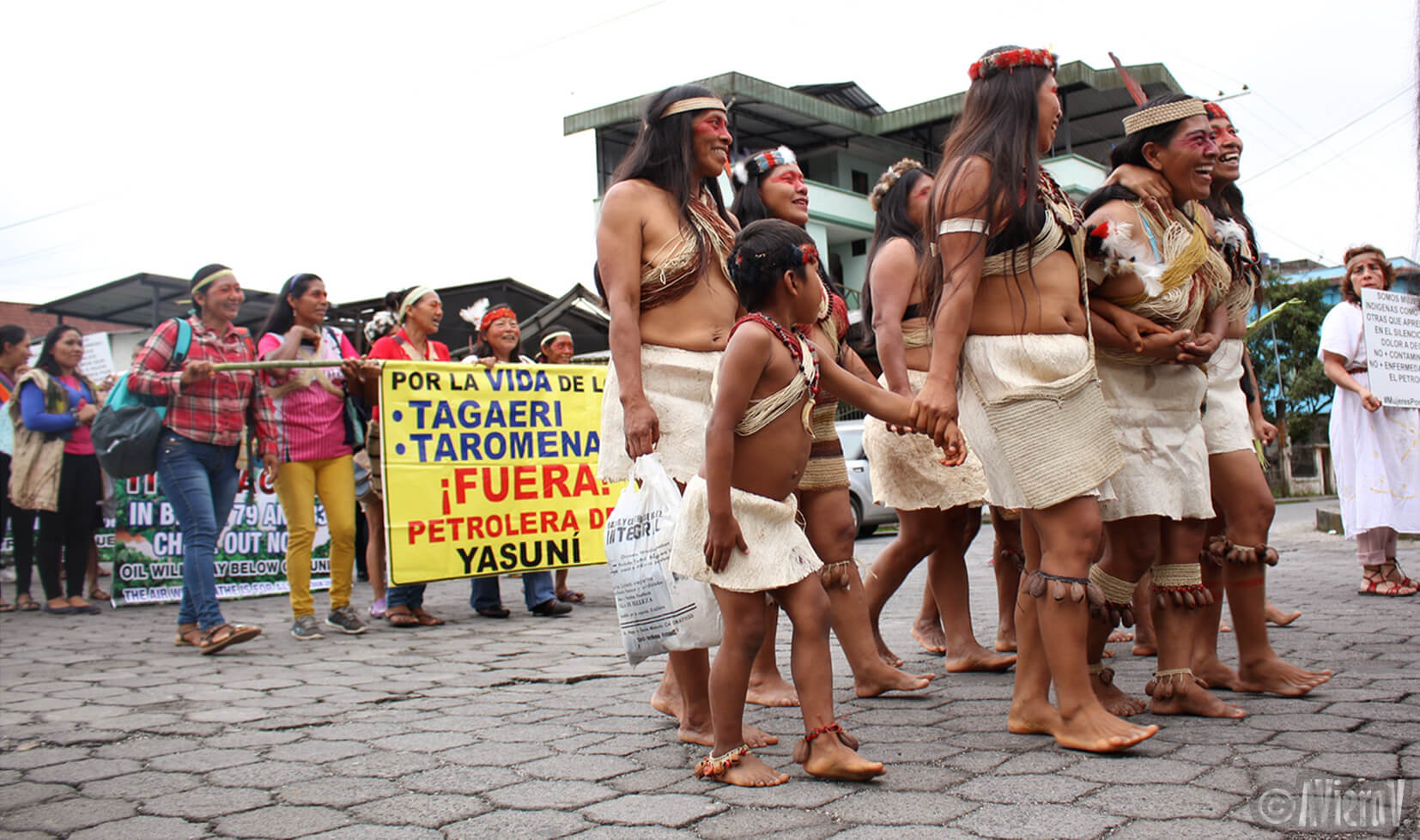
March in Puyo on Women’s Day. Credit: Andrés Viera V.
From the heart of Ecuador’s Amazon
In Puyo, the capital of Pastaza –Ecuador’s biggest Amazonian province–, Indigenous women from all over the Amazon region started off their own efforts to further pressure the government. Leaders of seven nationalities including the Andoa, Achuar, Kichwa, Shuar, Shiwiar, Sapara and Waorani were present at the event.
Led by female Indigenous leaders from the Confederation of Indigenous Nationalities of the Ecuadorian Amazon (CONFENAIE), the main Indigenous organizations in the Oriente region, the movement strategically crafted a bold agenda that extended for four days.
On March 8, seizing the visibility of the date, the events set off with a march that set the tone for their demands in defense of their territories. Around 350 Indigenous women from across the Ecuadorian Amazon marched down the streets of Puyo to speak up against the extractivist industries.
The message was clear: They had had more than enough of the contamination and exploitation of their territories.
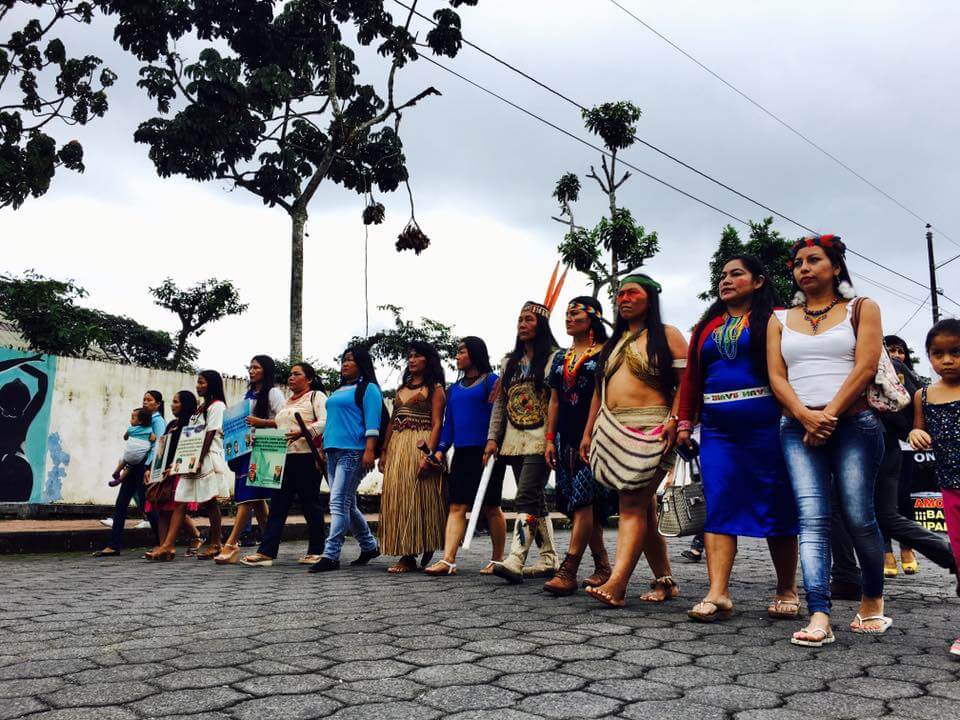
March in Puyo reassembling Indigenous female leaders from seven nationalities of the Amazon region. Credit: Yasunidos
The march was followed by a three-day gathering in Union Base, a landmark concentration spot at the outskirts of Puyo from where major Indigenous protests have been launched in the past. IC Magazine attended the event, which included the establishment of a women-only Assembly of Amazonian Women. For the inaugural session on Friday, March 9, around 400 assembly members had registered, including female leaders and representatives from across the country who had responded to the call of the organizers.
Upon inaugurating what was going to be a three-day session before embarking on a trip to the country’s capital, Elvia Dagua, CONFENAIE’s Leader of Women, reminded the audience that “Women’s Day is not March 8 alone, but every single day of the year.” This, she said, is because there is no life without women, before inviting the few male attendants to also join their cause.
“Together, men and women, we are going to defend our Mother Earth,” she said, as she opened the floor for participants to intervene.
According to Patricia Gualinga, a well-known Indigenous leader of the Sarayaku community and also a participant of the congress, the goal of this series of events is to make women’s voices and proposals heard. In her view, their aim is to awaken public opinion in the face of their latent fearsof what lies ahead. The government, Gualinga told IC Magazine, is calling for another oil auction in the South-East of the country’s Amazon, which is the reason why women are raising their voices in unity.
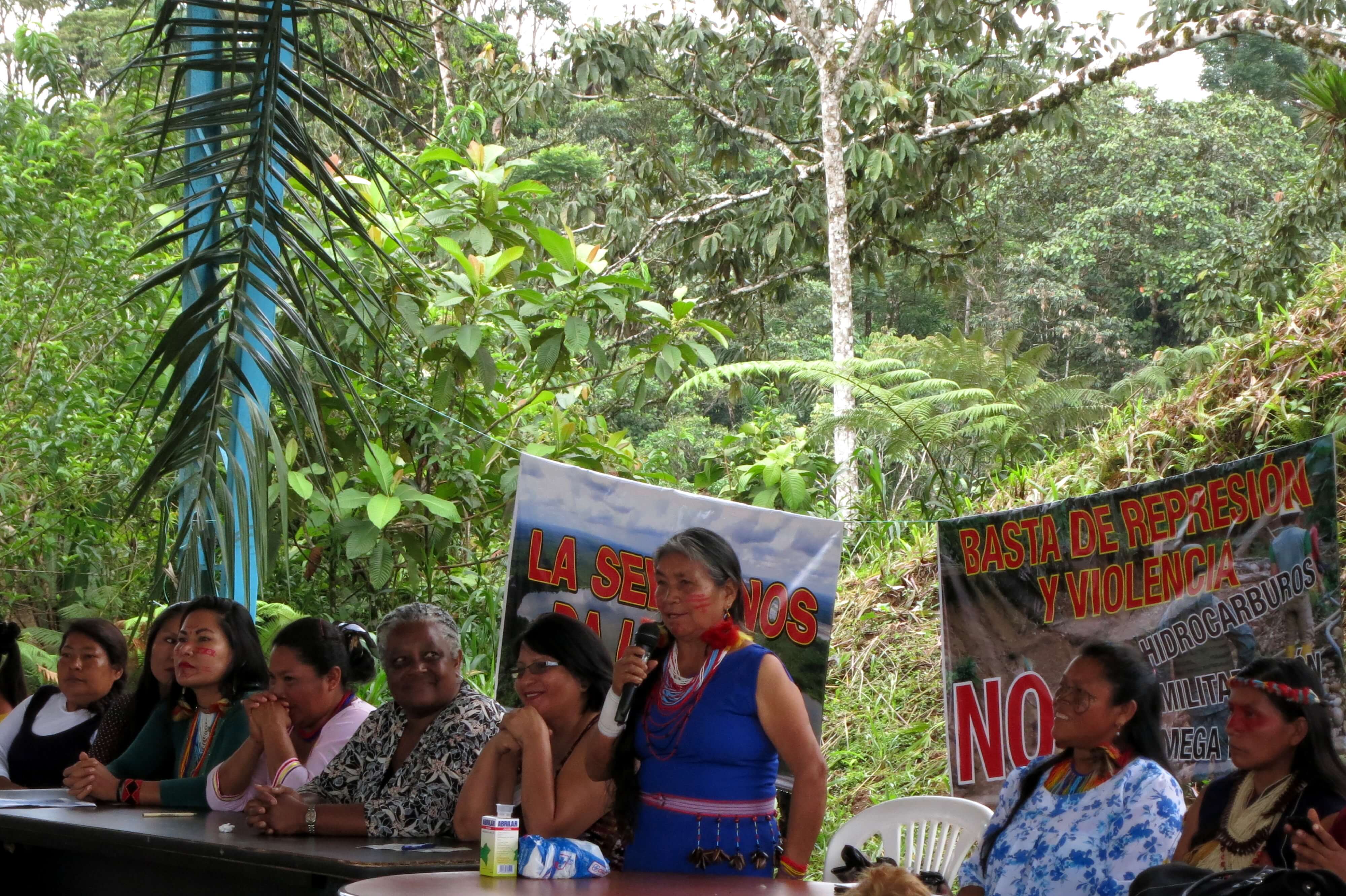
Leading panel for the Assembly of Amazonian Women on March 9 in Union Base. Credit: Ursula Cliff
Towards a different relationship with Nature
Throughout the opening session, assembly participants were asked to share their own experiences with extractivist activities, as well as to advance concrete proposals for overcoming them. Be it caused by mining or oil extraction activities, stories portraying violence and discrimination cut across themes that marked the interventions.
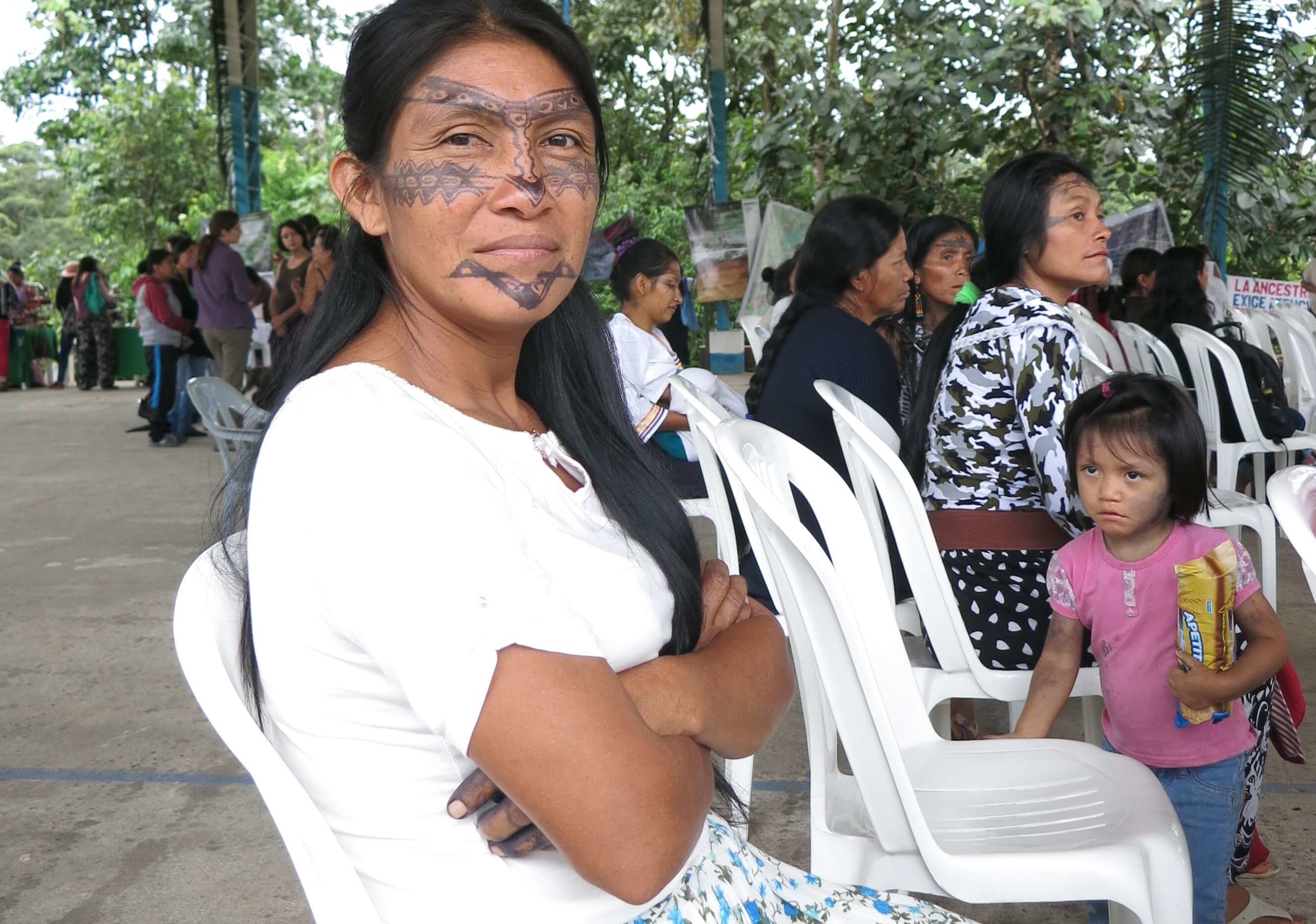
A participant at the Assembly of Amazonian Women. Credit: Ursula Cliff
Another recurring topic was the importance of such events in bringing together efforts to speak with one voice. Alexandra Proaño Malaver, president of the Andoa nationality located in the province’s far eastern border with Peru, expressed to IC Magazine her desire for local communities to further be included in such events.
“For us women, to talk about the defense of our territories and of life itself, we should do it from the communities” she said. The struggle should not only come from those women who live in the city, she explained, for it is “us, Indigenous women, that day by day are sowing and harvesting […] and thus sustaining life in our communities.”
Far from excluding men, all female leaders talked about a certain gender balance. Proaño, for instance, reckoned that “equity between man and woman is very important for [them]” while pointing out the experiences within her own nationality. A point that was further corroborated by Gualinga when she said, “We do not exclude men; we actually strengthen the relationship between (women and men).”
“This is simply a kind of space where we women regain our own voice,” she added.

Patricia Gualinga’s intervention in the Assembly of Amazonian Women unveiling the Kawsak Sacha project of the Sarayaku community. Credit: Andrés Viera V.
During her long-awaited intervention within the assembly, Patricia Gualinga unveiled her community’s proposal for overcoming the constant failures of what in her view are top-down approaches for the protection of the Amazon. Elaborated by members of the Sarayaku community, Kawsak Sacha, Living Forest in Kichwa is a new scheme when it comes to natural conservation, she said, that leaves the responsibility of the protection of the Amazon in the hands of Indigenous people.
In her view, this is a proposal that intends “to change the conception of everything that we have been taught at school,” for it is based on her own ancestral traditions and Indigenous ways of relating to Nature. The project’s goal, she said, is “to transform the whole scheme on which the current and obsolete economic system is based.”
Without providing further details as to the specifics of the project besides a major launch event in Quito in the coming months, Gualinga’s intervention served rather to spur the mood of the audience.
“This is a proposal for and by us; nobody has done the thinking for us,” she proclaimed in a boost to the pride of Indigenous women and their holistic relation to Nature that they want to share with the world.
Alicia Cahuiya, another experienced Indigenous leader from the Waorani nationality located in Yasuní National Park, shared with IC Magazine some key insights as to the overall message they are trying to send. “The government needs to understand that these are ancestral territories,” she said. “We don’t want more oil and mining companies; our territories need to be respected.”
Confronted with the government’s continued neglect, their message seems to preserve the living voices of the Amazon. “This is our home; here we have lagoons, waterfalls and animals and they all have spirits,” Cahuiya said, the government needs to grasp that “they all need to be included and heard, because our lives are interconnected with theirs.”
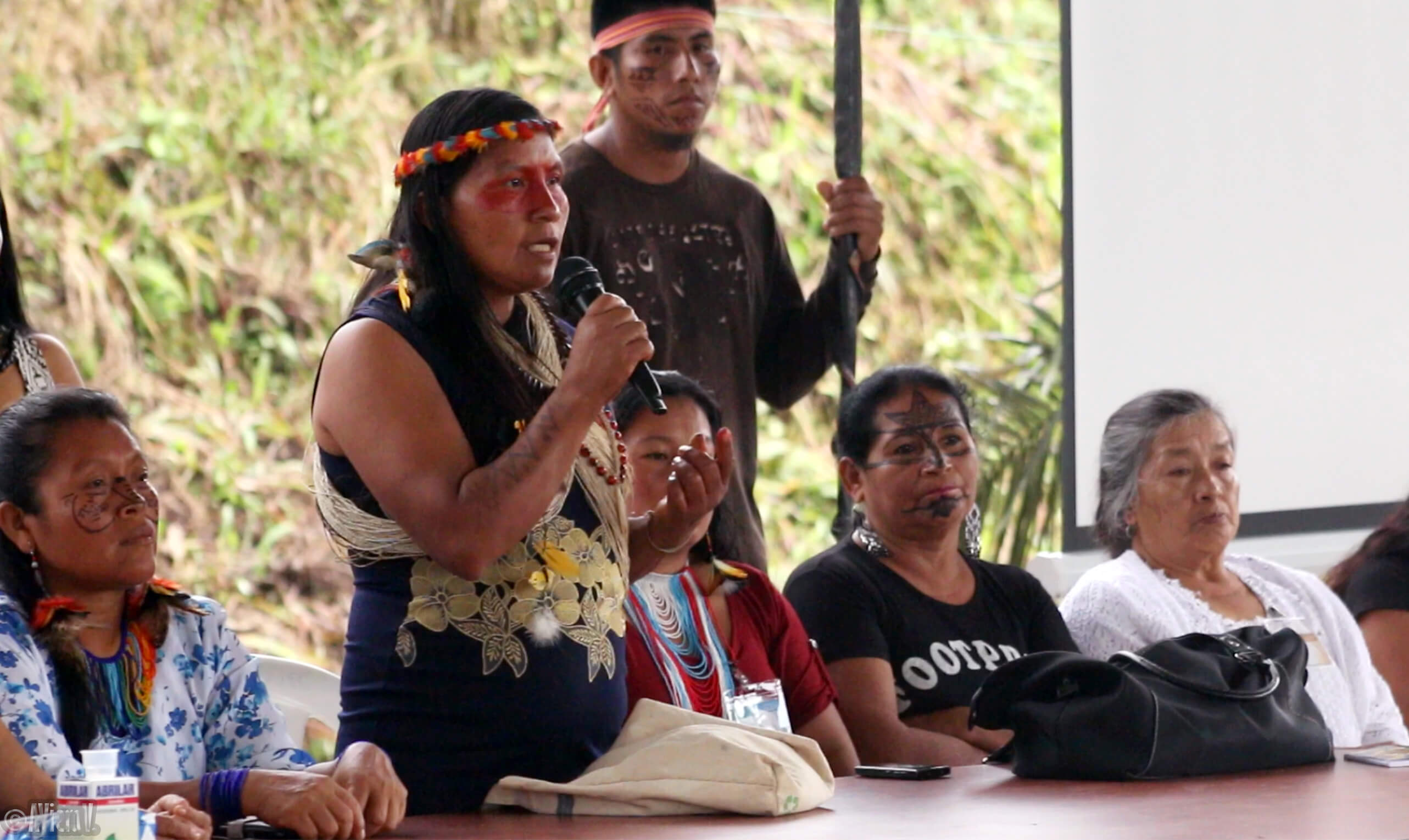
Waorani leader, Alicia Cahuiya, intervening in front of the Assembly of Amazonian Women to expose the dangers of the oil industry within the Yasuní National Park. Credit: Andrés Viera V.
Standing up in unity, directly defying power
The working sessions in Puyo resulted in a document that incorporated all their demands. The next and final destination was Quito, Ecuador’s capital, to hand down their ‘mandate’ to the President himself.
Indeed, on Monday, March 12, the march reached the capital for a press conference scheduled at the Independence Plaza, right in front of the Presidential Palace.
The collectively crafted document called Mandate of Amazonian Women included 22 specific requests headed by the most urgent demand: rejecting what they consider “illegal contracts or agreements between local authorities and any oil, mining, hydroelectric or logging company,” for “we are more than 50% of the Indigenous population, we are the carriers of life and take care of our families and Mother Earth.”
The document also included, among others, their rejection to the upcoming oil auction of 16 blocks located in Ecuador’s South-East Amazon region, their request to overturn recent oil concessions in blocks 79, 83, 74, 75 and 28, as well as their solidarity and demands for the liberation of Indigenous leaders Bosco Wisum and Freddy Taish, arbitrarily imprisoned for their upfront rejection of mining activities in Shuar territories in Morona Santiago, the country’s southernmost Amazon province.
Despite mild police repression in front of the Presidential Palace, the leaders of the Indigenous women conveyed their willingness to stay until the President hears them. As of the time of this publication, Lenin Moreno had not given any response. Whether he will attend those demands or not, the message has been clear. The striking echo of their demands will be hard to ignore, for voices of the Amazon have now joined their cause.

Indigenous women gathered at the Independence Plaza to hand down their demands to the president. Credit: Yasunidos
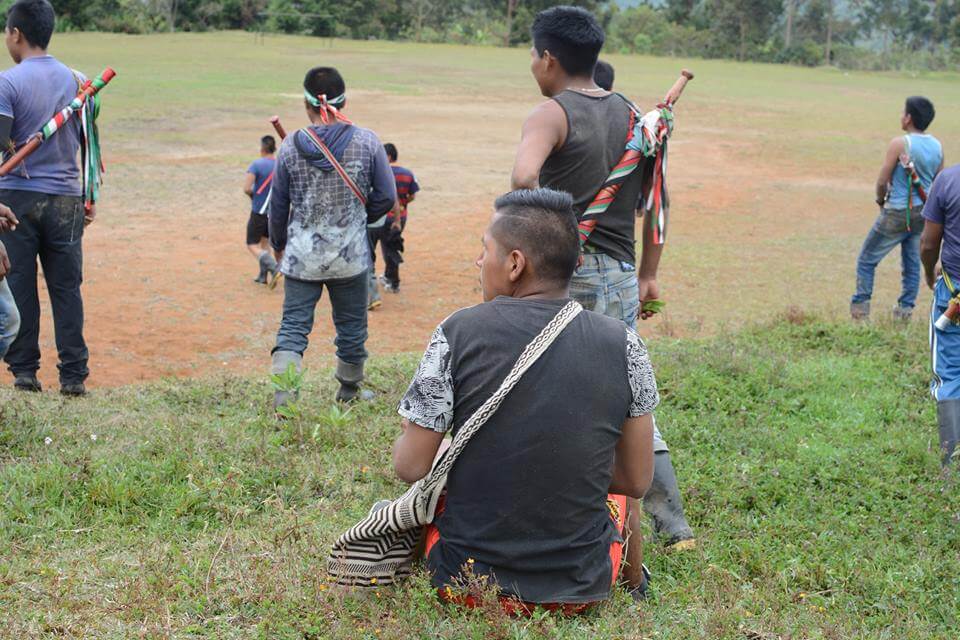
by Deep Green Resistance News Service | Dec 12, 2017 | Indigenous Autonomy
All images by Robin Llewellyn
by Robin Llewellyn / Intercontinental Cry
Colombian President Juan Manuel Santos may have received the Nobel Peace Prize, but peace has not come to Colombia. Social leaders and members of indigenous communities have been targeted in a wave of assassinations that has swept through the countryside during this supposed “post-conflict” era–and the state has failed both to stem the killings and to curtail the spread of illegal mining and drug trafficking.
Indigenous guards are elected by their communities and mandated to protect Indigenous lives and territory without the use of arms. Throughout both the civil war and the undeclared battle for territory and resources that has followed it–and carrying only the staffs that serve as their mandate of office–Indigenous Guards have been killed by non-state armed groups of the left and the right, by the forces of the state, and by mafias unaligned to political ideologies. Yet they have also succeeded in arresting heavily armed opponents and submitting them to the justice systems of indigenous territories and the state.
Today new challenges arise as communities consider whether Indigenous Guards should be paid and become professionals, and whether or how they should integrate their function with that of the Colombian police.
No region of Colombia has been more affected by the newest wave of assassinations than the department of Cauca in the southwest. The reservation of Juan Tama lies on the border of Cauca and Huila departments, high up in the Sierra Central. Juan Tama contains a training ground where Indigenous Guards from Nasa, Misak, and Yanakona communities regularly meet to challenge each other and themselves.
Intercontinental Cry recently had the opportunity to visit Juan Tama during one of these spirited competitions.


Indigenous guards gather for the meeting that precedes the race.

Over the course of one single day, teams of indigenous guards must go through an obstacle course that has to be completed while racing against the clock. This particular event saw a competition between Nasa, Yanakona and Misak reservations from across Cauca and Huila.

“Guardia!” In advance of the race the indigenous guards come together, forming lines for each participating reservation, that meet in the center to form a star shape. The responsibilities and values of the Guardia are pronounced, and the aims of the competition clarified. This event saw a competition between reservations from across Cauca and Huila, including reservations of the Nasa, Yanakona and Misak peoples. All Photos by Robin Llewellyn

The obstacle sees regular competitions with indigenous guards from several reservations taking the opportunity to improve their teamwork and strength.

Guards practicing on the assault course before the competition.



Children play on the assault course as guards practice before the competition.

An Indigenous Guard takes his time completing an obstacle. When racing against the clock, it becomes much more difficult.
The life of an indigenous guard is not for the faint of heart. It comes with great personal risk and an even greater responsibility, as Fredy Chikangana, a poet and ‘Amauta’ (An Amauta is a Qechua word translated to mean, “messenger from the ancestral knowledge of the Yanakona People”) from the Yanakona reservation of Rioblanco, would tell us in a later interview.
Fredy Chikangana told us that, “[B]eing an indigenous guard is a great responsibility in terms of the community and the territory. It is not just a matter of carrying the staff of office without commitment: there is a mission and it has to do with culture, with maintaining harmony in the community and maintaining harmony with Mother Earth.”
“To be an indigenous guard is a question of knowing to accompany the good work of the indigenous authorities, but if an authority fails, one also has to remember one’s ultimate obligation.”

The first team that raced against the clock. This particular obstacle consists of barbed wire strung between posts.
“The ancestors had various names for the indigenous guards of their day,” Fredy explained. For instance, there is ‘Aukaruna’ which is the Qechua word for a warrior, and ‘Aukas’ who were the vigilant beings of the forests.”
“To be a good indigenous guard one needs to have physical and mental readiness. It’s not just strength, it’s also the capacity to solve problems for the wellbeing (“buen vivir”) of the community.


A good indigenous guard also understands their culture–and they “[know] how to look at different approaches to be able to help their community.”
“He or she who is an indigenous guard must above all have caution and respect for the other, but also decisiveness when one has to act to defend the territory and the community,” he continued. “There are male and female indigenous guards in the same way there is the moon and the sun. Everyone knows how to enter a dialogue with their own gender, but in defense of the land, culture, and Mother Earth all are equal and act as if woven together.”
“To be an indigenous guard is to narrate between generations, to protect the rights of all.”

Balance, athleticism, and dedication are developed throughout the course: this obstacle is only ruled completed when the guard lands and launches in one movement into a forward role through mud.

Belsi Rivera is an indigenous guard in the Nasa reservation of Nasa Kiwe. She took part in the struggle for control of the Cerro de Berlin Mountain in Toribio, Cauca, that was occupied by the army. She also works with children for the educational institute of Nasa Kiwe.
Belsi told us, “The Nasa People have a history of struggle and resistance that is based in love for Mother Earth; she is the fount of energy because according to our cosmogony we are part of her and we see her reflected in our authorities such as our governors and our indigenous guards, and more specifically in the staffs of office that are carved from chonta wood that symbolizes both territory and legitimate authority. The staffs are bound by three hoops, each symbolizing a realm within our world-view.”
“The first realm is that of above, where the ‘sxaw’, the great spirits, live. The second is the middle realm where the animals and trees share the territory of the Nasas (known as the people who are children of water and the stars). The third realm is that of below, where water lies hidden and where minerals exist and must remain.”
“There were times in the past when the people struggled against the colonists who had come to evict and assassinate us, and we took up arms to defend ourselves,” Belsi continued. “This negatively affected our ideas and our respect for life, so we renounced arms and looked again to restore equilibrium. The struggles continued with the great idea of protecting our Mother Earth, and gradually we developed the idea that there needed to be people solely dedicated to being protectors, even though all people can and should pursue such goals. The ‘kiwe thegnas’ or indigenous guards have the permanent responsibility of establishing control and protection of the territory and of defending life and our Mother Earth.”

Another team races to complete the exercise.
“The indigenous guard is very involved in protecting the community when it seeks to liberate Mother Earth from the mono-cultivation of sugar and pine plantations, and to return that land to the community which was stolen from our ancestors. When we speak of the Liberation of Mother Earth, many call us criminals, but they don’t understand the importance for us of these spaces, and that to have them appropriately used is necessary for our harmony and spirituality. These lands are today owned by non-community members who have enslaved the collective goods for their own profit, and spread contaminants in the pursuit of making capital.”

Members of the community watch the race. The crossing the bog on a pole proved the most popular spectator attraction.


Jesus Bacca Guijano is an indigenous guard in the Nasa reservation of Munchique los Tigres, who has sought to protect water sources from the impact of mining and an unauthorized waste dump, both controlled by businessmen of the Sadovnik family. When Bacca led opposition to mining as president of the local JAC (neighborhood action committees – Junta de Accion Comunal), one of the Sadovniks sought to paint him as a member of the ELN guerrilla group. Bacca was detained but found not guilty. Today, the current governor of Munchique los Tigres is enabling an institutional process that would ensure the continued operations of the Sadovniks’ mine and dump sites. Bacca has continued to speak out against the plans; last month, reservation authorities placed charges of calumny against him.
“As indigenous guards, the staff is a symbol of resistance and of the survival of all the community: of all who continue to live committed to the reservations and the territories. To me it’s symbolic of every member of the community of Munchique los Tigres, not just the indigenous guards,” Bacca told us.

After crossing the pole over the bog guards enter a mud-tunnel. Obstacles develop strength but also test competitors with mental challenges such as claustrophobia.
“Our Nasa reservations are guided by planes de vida (plans of life – multi-year strategies for self-government) that are agreed in open sessions of the community, and our plan de vida says that we were born of water. Our mandate as indigenous guards is to liberate land [members of Nasa communities are involved in a struggle for land with local sugar haciendas, as well as with owners of operations within reservations such as the initiatives of the Sadovnik family] together with the members of the community who don’t have land. We are also obliged to liberate the sources of water, and the people understand this well. People can’t be legally persecuted by the indigenous authorities for liberating the land when it’s our mandate.”



The latest charges against me haven’t been investigated in front of a communal assembly; they’re just another example of the attacks that are causing disharmony in the territory and in members of the community. Frequently, we who have denounced the rubbish dump have received death threats from the paramilitaries such as the Aguilas Negras and Clan del Golfo. The governor is the legal representative of the community, and the governor must consult with the community in an open assembly. We haven’t seen this which has caused disharmony.”

Competitors race towards the finish line.
“As indigenous guards we must not receive funding from the state because we’d lose our identity; however it would be a good idea to have projects that would assist not ourselves but our families, so that if there is little work available they could still feed themselves when we are away serving with the indigenous guard.
I believe in a concept of the territory as being open for those who come from outside, who come here and respect it and want to live amongst us as members of the community. All can be members of the community.”

As the day came to a close, the Indigenous guards formed in lines to hear their final times; but in the end, the scores didn’t matter. Everyone agreed that the value of teamwork was a lesson all competitors shared–and because of that shared learning, all competitors won.

Indigenous guards pose for group photos after completing the exercise.

Guards from a reservation in Huila gather for a group photo after completing the race.

Indigenous guards pose after completing the race.

A clean guard gets surprised by the muddied competitors.


Later on, the Guards debated about how to encourage greater participation of female guards in future competitions.
They also spoke about the importance of maintaining readiness so that they can respond swiftly and effectively to the violence that is now taking place.

Indigenous guards of a reservation in discussion after the competition.
“For Indigenous Guards”
A poem by Fredy Chikangana
I only understand how to be a Guardian of the heavens,
For which one needs to know to be calm in the storm,
To have the clouds as good counselors and the sun as
The father that illuminates the path and
accompanies one into the darkness.
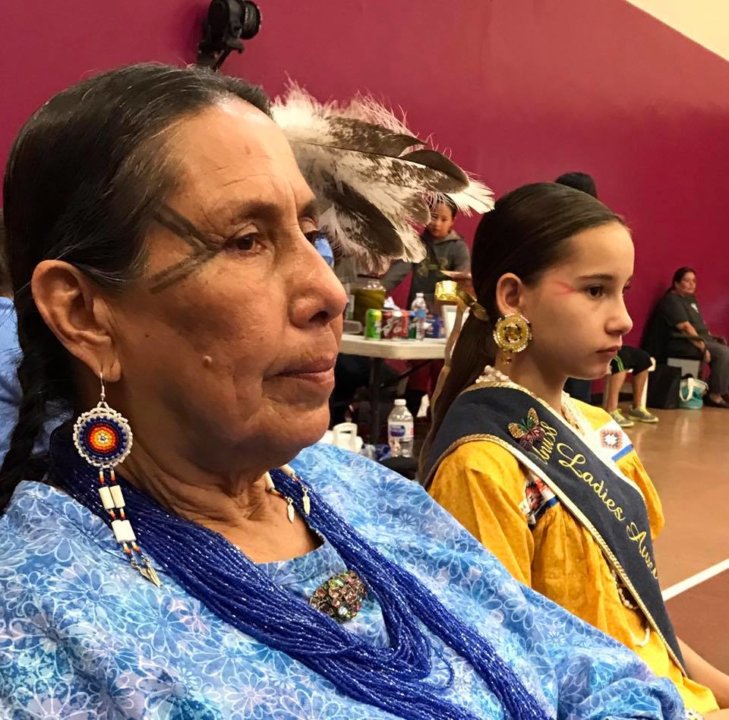
by Deep Green Resistance News Service | Nov 1, 2017 | Indigenous Autonomy
Featured image: Casey Camp-Horinek with her granddaughter
by Movement Rights / via Intercontinental Cry
San Francisco, CA – After suffering for years with poisoned water and serious health issues due to fracking and injection wells on and near their reservation the governing body of the Ponca Nation of Oklahoma voted to pass a statute recognizing the rights of nature on Friday, October 20, 2017. When enacted, the Ponca will be the first tribal nation to recognize the rights of nature into statutory law.
“On Friday, October 20th the Ponca Tribe of Oklahoma took the historic step of agreeing to add a statute to enact the Rights of Nature. We are proud to be moving into the future by honoring our original instructions to respect all life on our Mother Earth,” said Casey Camp-Horinek, a member of the Ponca Tribal Business Council. “We would like to thank everyone who has brought information about the Rights of Nature and those who continue to share ways to bring back respect for the natural laws that have sustained all life for millenniums. A special thanks to Movement Rights founders, Shannon Biggs and Pennie Opal Plant for all the support provided over the last few years.”
Movement Rights has been working with members of the Ponca Nation to assist the tribe with fracking issues utilizing the recognition of the rights of nature as a model to protect the land and health of tribal members. “Dozens of communities in the United States and several countries, including New Zealand, India, Ecuador and Bolivia, have passed laws that stop treating nature as property to be destroyed. The rights of nature legal framework recognizes the legal rights of ecosystems to exist and regenerate their vital life cycles,” said Shannon Biggs, the Executive Director of Movement Rights. “These communities and countries are using this new legal framework to protect people and natural communities from harmful activities including fracking. They are shifting human law to align with natural law.”
Ponca, Oklahoma is the epicenter of earthquakes caused by fracking and injection wells. Tribal members have experienced diseases that have decimated their population since the fracking industry began in their area. Every single water well on the reservation is too toxic to drink, bathe in or allow pets and livestock to drink. There have been 448 earthquakes in and around the Ponca reservation this year, in a state that was essentially earthquake free before the fracking industry moved in to the area. The Ponca Nation is expected to enact the Rights of Nature Statute into law by the end of 2017.
“We all know that water is life. The years of fish kills related to the fracking and injection wells amount to environmental genocide,” said Casey Camp-Horinek. “It is going to take all of us humans because we’re speaking for those without voices, for the deer, the cattle, those that fly. In our tribe we have a funeral a week now. We’re being fracked to death and It’s time to take a stand for our people and defend the earth.”
The Ponca Nation and Movement Rights also conducted two events which took place on Saturday, October 22nd called “Ponca Environmental Community Action Day”. The day included a prayer walk to the Phillips 66 refinery in the City of Ponca as well as a community meeting. “I feel like we are gaining strength, we had more tribal nations represented this time as well as non-natives,” said Ponca Tribal member, Suzaatah Williams. “We had elders and even a newborn on this walk and every age group in between. Even if only one of these people share the information they learned we have made a difference. Knowledge is power and we are only getting stronger!”
Speakers for the community events included Casey Camp-Horinek, Mekasi Horinek, Shannon Biggs, Bryan Parras of the Sierra Club and TEJAS in Houston, Texas, and Robby Diesu, coordinator for the National Stop the Frack Attack Network based in Washington, DC.
“Most importantly, thanks to our Creator, Wakonda,” said Casey Camp-Horinek. “We believe that the prayers and guidance provided are leading us to further protect our Mother Earth, who sustains us; and make a way for the generations to come.”
Contact:
Casey Camp-Horinek caseycamphorinek@yahoo.com (580) 716-7015
Shannon Biggs shannon@movementrights.com (415) 298-9419
Pennie Opal Plant pennie@gatheringtribes.com (510) 390-0386
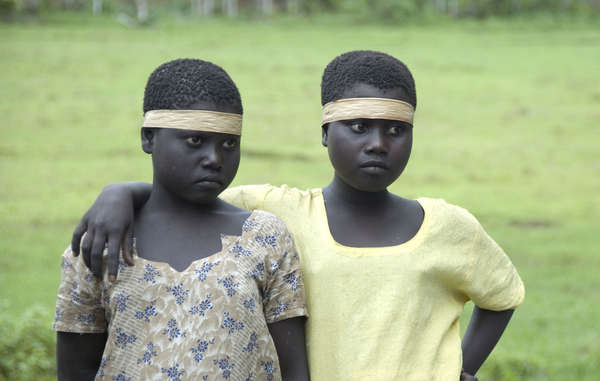
by Deep Green Resistance News Service | Sep 19, 2017 | Indigenous Autonomy
Featured image: Human safaris have risked exposing the Jarawa to diseases to which they have no immunity. © Survival
by Survival International
Notorious “human safaris” in India’s Andaman Islands may soon stop, after the authorities announced that a new sea route around the islands will soon open.
The new route will keep tourists off the infamous Andaman Trunk Road, which was built illegally through the forests of the isolated Jarawa tribe.
The road brings a daily invasion of hundreds of tourists into the heart of the Jarawa reserve, who treat the Jarawa like animals in a safari park.
One tourist described his trip: “The journey through tribal reserve was like a safari ride as we were going amidst dense tropical rainforest and looking for wild animals, Jarawa tribals to be specific.”
The Jarawa, like all recently contacted peoples, face catastrophe unless their land is protected.
The human safaris are also dangerous – one Jarawa boy lost his arm after tourists threw food at him from a moving vehicle.
In 2002 India’s Supreme Court ordered the road closed, but it has remained open.
Survival International led a global campaign against the human safaris, calling for a boycott of the Andaman tourist industry until they came to an end. Nearly 17,000 people from around the world pledged not to holiday in the islands in protest.
The boycott will be called off as soon as the Andaman government agrees to ensure that tourists are no longer able to use the road.

A tourist poses with a group of Jarawa. © Mauricio Cordova / Survival International 2008
Background briefing
– In 2012, shocking footage emerged of Jarawa girls being made to dance at the side of the road, during a human safari. This led to a global outcry against the dehumanizing use of tribal people as tourist exhibits.
– The Jarawa are one of the tribes indigenous to the Andaman islands. They live as hunter gatherers, and chose to reject contact with mainstream Indian society until 1998. Several other Andamanese tribes were wiped out following British colonization of the islands in the 19th century.
– In 1999 and 2006, the Jarawa suffered outbreaks of measles – a disease which has devastated many recently contacted tribes. and which is often a consequence of forced contact.
-Tourism is a major industry in the Andaman islands. The new sea route will be used to access the north of the islands and attractions like the limestone caves and mud volcano at Baratang without tourists intruding into the land of the Jarawa.
– The Islands’ Lieutenant-Governor, Professor Mukhi, announced recently that the sea route will be quicker and more comfortable than the current journey by road.

Still from video showing Jarawa girls forced to dance during a human safari. © Anon
Survival’s Director Stephen Corry said: “Treating the Jarawa as a tourist spectacle was a disgusting practice – it also put their lives in danger. It’s more than time for the human safaris to end. If this sea route can do that, then we welcome it. If not, we’ll carry on campaigning until the Jarawa’s right to determine their own futures and stop being harassed by tourists is secure.”

by Deep Green Resistance News Service | Sep 18, 2017 | Indigenous Autonomy
by Rawiri Taonui / Cultural Survival
This month marks the 10th anniversary of the signing of the Declaration on the Rights of Indigenous Peoples (UNDRIP 2007). Indigenous Peoples have come a long way. Our individual struggles coalesced during the 1970s in the Indigenous-initiated World Council of Indigenous Peoples. A decade of consultation and negotiation through the United Nations culminated in a first draft. Some of those who had worked on the draft lost their lives in struggles at home.
Consultation with states followed. On one side, the will of Indigenous representatives to craft a document worthy of the aspirations of first nation communities; on the other side the reservation of states.
The chair of the first Intergovernmental Working Group refused Indigenous representatives the right to speak. Silence incompatible with a voice seeking freedom, a walk out followed, the rules were changed and discussion proceeded. A New Zealand representative once described the Declaration as constituting discrimination – an easy allegory for an uneasy conscience.
The Declaration
On 13 September 2007, the UN General Assembly passed the Declaration – 143 countries in support, 4 against and 12 abstaining. The culmination of 500 years of struggle against colonisation, racism and neo-liberalism, every passage in the Declaration is a response to injustices suffered by Indigenous Peoples.
The preambulatory paragraphs and articles affirms the collective and individual human rights of First Nations as Peoples and human beings and in doing so proclaims our equality with all other members of society. The Declaration provides a framework for reconciliation with nation states by mapping a pathway to overcome the historical denial of our rights and established the minimum requisite standard for our advancement and the restoration of our dignity.
Our Place as Indigenous Peoples
The Declaration reminds us that the sovereignty of the States that came to wield power over us was not attained through “free and intelligent consent”, but through the trickery or absence of treaties, through warfare the coloniser called conquest, victory and the Christian mission, which today we understand to have been cultural genocide, the unjust alienation of our territories, the suppression of our languages, forced cultural assimilation, the inter-generational marginalisation of our societies at all levels, including the taking of our children through Residential Schools in North America, the Stolen Generations in Australia and in New Zealand through what were “State Care Homes.”
The Declaration has lifted the confidence of Indigenous Peoples. Our rights are more visible. We are important. We are the descendants of the first arrivals or earliest surviving occupants of a land. We number between 350 to 500 million people living in up to 90 countries. We comprise 5,000 distinct cultural groups speaking 4,000 of the world’s 7,000 languages. We are home to 90% of the world’s cultural diversity.
We live upon 22 per cent of the Earth’s land mass harbouring 80 per cent of its remaining biodiversity. Our cultures, ancestral knowledges and philosophies are deeply embedded within the environment; the Skyfather, the Earthmother and their children are our relations. Once belittled, our epistemologies are integral to the survival of the planet.
Progress on the Declaration
Several of the original abstentions, such as Colombia and Samoa, now support the Declaration; 182 States at the Durban World Conference on Racism endorsed the Declaration. Having overcome the self-inflicted trauma of their previous hesitation, the governments of the United States, Canada, Australia and New Zealand now support the Declaration.
God may also be on our side, Pope Francis’ 2015 encyclical on meaningful climate action declaring that Indigenous Peoples “should be the principle dialogue partners” on matters concerning the environment and that when our land rights are protected we are the best guardians of the world’s forests and biodiversity.
Guided by the principle that “no one is left behind”; Indigenous Peoples are a priority under the UN 2030 Agenda for Sustainable Development.
From the Waitangi Tribunal and courts in New Zealand where the Declaration reinforces the 1834 Declaration of Independence and the 1840 Treaty of Waitangi, to Belize, Bangladesh and the African Commission on Human and People’s Rights the international judiciary is increasingly citing the Declaration. Many more cases are going before the Inter-American Commission on Human Rights and Court of Human Rights, and the rulings and decisions are supporting the protection of Indigenous rights.
Indigenous rights are being recognised in new laws and/or being enshrined in constitutional instruments. South America has been an important leader, in particular Bolivia under the leadership of President Evo Morales.
In Asia, Myanmar and Japan are considering greater recognition. In Europe, Denmark has granted greater self-government to Greenland where 90% of the 56,000 population is Inuit.
In Africa, the Republic of the Congo, the Central African Republic, Kenya, Namibia and Burundi have taken steps to recognise Indigenous Peoples. Others have processes in place.
Where once the killing of Indigenous People was conducted with impunity – the historical massacres in Australia, the Trail of Tears and Wounded Knee in the United States, and Handley’s Woolshed, Rangiaowhia, Ngā Tapa in New Zealand – there is increasing accountability. The leader of a militia that massacred Mbuti Peoples in the Ituri forest was sentenced to 18 years in prison. There have been arrests in Honduras for the killing of the distinguished Lenca leader Berta Caceres shot dead in 2016.
Challenges
Many challenges remain. Even where the countries have adopted the Declaration, most have not been able to implement it effectively.
Compromises in the Declaration from discussion with states will be difficult to overcome. States objected to Article 3 the Right to Self-determination. The compromise in Article 46, essentially that Indigenous Peoples cannot form new states, reinforces uncertainty and dislocation for Indigenous Peoples straddling the borders of nation states. The Karen spanning the river border between Thailand and Myanmar, the Guarani spread between countries across the Amazon, and 30 million Kurds, the largest nationality in the world without a country, are divided between Iran, Iraq, Syria and Turkey.
We are losing one Indigenous language every two weeks. We remain the world’s most vulnerable peoples. At 6% of the world’s population we are 15% of the world’s poorest peoples. Wherever we live, we are the poorest of the poor.
It is unlikely that we will realise the goal of equality under the 2030 Agenda for Sustainable Development because it does not prioritise the right to self-determination or the principle of free, prior and informed consent and therefore will not prevent the avarice of development that threatens many Indigenous Peoples. Every year were hear submissions at the Permanent Forum on Indigenous Issues and the Expert Mechanism on the Rights of Indigenous Peoples echoing the words “we may not survive.”
Extractive Industries
The majority of new extractive industry projects, including mining, drilling, hydro-electric, forestry and agribusiness, are in Indigenous areas from the Artic to the Amazon, from West Papua to Africa. Drilling and fracking quench an insatiable thirst for oil. Agribusiness feeds a gluttonous demand for beef burgers. Environmentally friendly biofuels have unfriendly impacts on first communities. Coltan, tin and tungsten build our cell phones, laptops and flat screens.
The extractive industries cost many lives. It is sobering to apprehend that in the ten years since the signing of the Declaration the annual number of individual Indigenous human rights advocates being killed has doubled to 600 per year.
Directly and indirectly, these industries have cost 100,000 West Papuan lives since 1963. From 1998 to 2003, 10,000 to 70,000 Indigenous peoples lost their lives in the conflict mineral regions of central Africa. Alongside gorillas and elephants some were eaten as bush meat supplying militias.
The Struggle for Identity
Many Indigenous Peoples struggle for recognition. China supported the Declaration, an official once stating because there are no Indigenous people in China. There are 10 million Uighur, 2 million Tibetans and 13 million Yao-Mein and Miao-Hmong.
India recognises 400 groups numbering 84 million people as Scheduled Tribes; over 600 groups numbering at least the same are not recognised. Russia recognises ‘northern groups’ as Indigenous but only if their population is smaller than 50,000.
The San, Khoi, Mbuti, Mbenga, Twa and Batwa are the earliest African Indigenous Peoples and oldest cultures on Earth. Botswana, Zimbabwe and Zambia do not recognise their indigeneity.
Racism, Violence and Suicide
Indigenous Peoples continue to face grave racism. In developed countries this has a “new colourism.” Dominant institutions prefer indigenes if we are compliant, middle class, fair skinned and have European features.
Indigenous women and children continue to endure significant violence. There is an emerging world-wide crisis in Indigenous suicide.
New Zealand acknowledges the UNICEF Building the Future report saying that at 15.6 per 100,000 we have the worst adolescent suicide rate in the developed world. What is not recognised is that the national figure is elevated by a high Māori youth suicide rate, often double or more than for non-Māori, in conjunction with their higher proportion of the national population proportion (35% under 15 years old; 27% between 15 and 40) when compared with other Indigenous situations. The crisis is Māori suicide.
Comparative figures demonstrate that the Indigenous suicide rates in Canada, Australia, the United States, and among the Nenets of Russia, the Guarani of Brazil and the Sami of Scandinavia are equal to, or higher than Māori. However, they do not lift their national average in the same way because the Indigenous demographic is a significantly smaller proportion of the national population than that of Māori.
If we do not understand the problem then we miss the best solutions. Mainstream approaches to suicide focus on mental health, bad parenting, drug addiction, crime and poverty. These approaches have their place, however, they are also driven by underlying deficit assumptions about the inferiority of first cultures.
In the case of Māori, historical research shows that pre-European Māori were good parents; before 1900 when the language was intact Māori were just 3% of prisoners – today they are 50%; before the mass urbanisation of the 1950s every Māori knew their marae and subtribe and suicide was half that of Europeans. A Canadian study has shown that where 50% or more of an Indigenous community speaks their language suicide is between half that of other communities and zero.
Cultural alienation as anomie is a causal factor so too its relation racism and discrimination. They compress Indigenous youth between two worlds and a past they do not understand, a present that does not understand them and a future without hope.
The Future
The Declaration is not perfect. A lack of action by governments is the greatest impediment to progress. Nevertheless, the journey has begun. We live in a new world.
Standing Rock has taught us of the power of social media in the fight to raise consciousness.
New allies may benefit the cause of Indigenous Peoples. North America and Europe require 100 million new immigrants each by 2050 to support ageing European populations. Many immigrants suffered oppression in old countries and confront racism in new lands. In a country like New Zealand the combined Māori, Pasifika and immigrant community will equal and then surpass the European population somewhere around 2050. We are natural allies and will be the majority of the work force, the parliamentarians and the decision makers.
There is a changing of the guard between the West and the developing world. Alt-right and the American presidency are a reaction to that. In 2050, 27 of the fastest growing economies in the world will be formerly oppressed brown colonies. Those who can work with other cultures as equals will be a force for change.
There are risks. We need to stay grounded with the lowest common denominator in our communities and the realities of other Indigenous Peoples, use our proven resilience and capacity to fight for our rights and survive in the face of great difficulties to take all our people forward in emancipatory praxis.
We need to be cognisant of the risks of building a self-serving middle class, confining power to small elites or suffering rigid cultural nationalism lest the formerly oppressed becoming the new oppressor. For those who survive the next generation there is a future.
–Rawiri Taonui is a professor at the College of Humanities and Social Sciences & Global Centre for Indigenous Leadership at Massey University in New Zealand.
This paper was presented at the Conference on the UN Declaration on the Rights of Indigenous Peoples on 5-6 September 2017 at Te Papa Tongareva – Wellington Museum, New Zealand.

















































